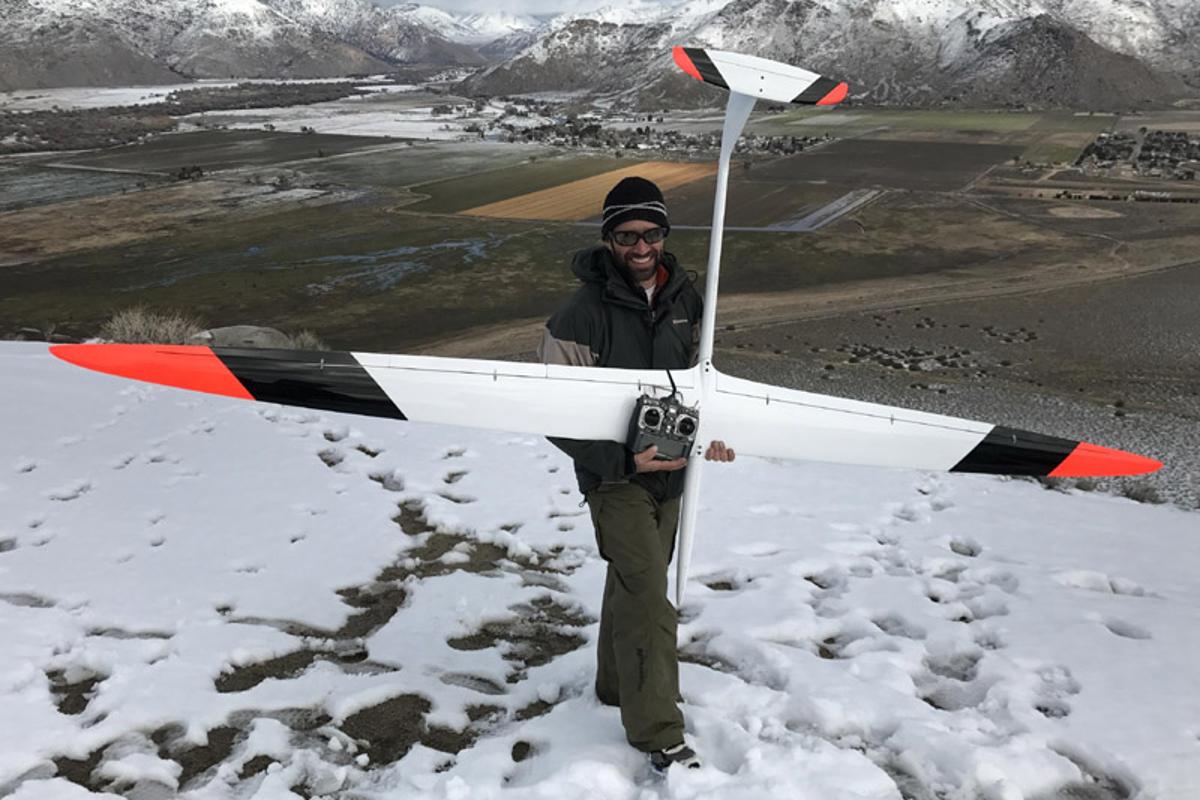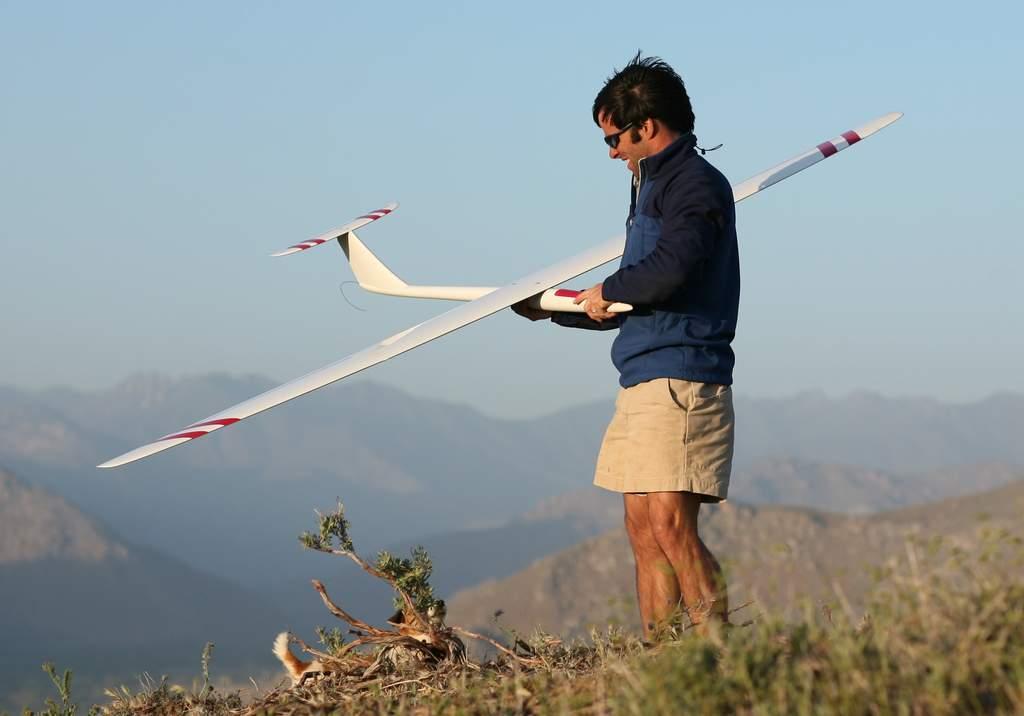DIY-HP-LED
Well-Known Member
World's fastest RC aircraft hits a stunning 548 mph – without a motor (newatlas.com)
World's fastest RC aircraft hits a stunning 548 mph – without a motor
By Loz Blain
January 21, 2021

Spencer Lisenby with the massive DSKinetic 130-inch Transonic DP RC glider
DSKinetic
VIEW 5 IMAGES
No props, no jets, no rockets – California's Spencer Lisenby just broke the world speed record for remote controlled aircraft, taking an unpowered RC glider transonic at 548 mph (882 km/h) using nothing but the wind. Well, that and an incredible degree of skill in a highly dangerous technique called dynamic soaring. And while it's more or less an extreme hobby at the moment, he's got some very interesting plans for the technique and the technology behind it.
Wind accelerates like mad when it goes up a hill, and since the 1960s, "slope soaring" radio-controlled glider pilots have used that reliable source of energy to keep their aircraft flying pretty much indefinitely – as long as they take care to avoid the wild, plane-eating turbulence of the "shear layer" on the leeward side behind the hill where that fast-moving air begins interacting with the much slower air shielded behind the ridge.
But in the last 20 years, a group of intrepid RC glider fanatics has been experimenting and perfecting the art of plunging through that shear layer in a loop, using the extreme push of high winds to accelerate the gliders on the way down, and the still air under the shear layer as a way of returning most of the way upward without losing energy flying into a crazy headwind. The aircraft gains roughly the speed of the tailwind every time it goes down, and loses much less on the way back up, picking up energy and speed on every loop.
Not that these hobbyists invented the technique; the black-footed albatross has been using exactly this flight pattern for millennia, harnessing the wind speed differentials created by ocean swells to traverse long distances, in any direction, without expending any energy.
"I've even read that they can perform this maneuver in their sleep," Lisenby told an audience at the TNG Technology Tech Day back in 2017, "with their wing tip mere centimeters from moving water. We all aspire to the skills of the albatross. But they're usually trying to go somewhere. We're going for speed."
Dynamic soaring, or DS, might sound innocent enough as a title, but these extraordinary pilots are now taking unpowered gliders up to transonic speeds, perilously close to the ground. Continue tuning and optimizing that tilted loop between the high and low air speeds, and the glider gets faster and faster, until either the pilot messes up the loop, the aircraft disintegrates spectacularly under extreme G-loading or flutter stresses, or you reach an airspeed where drag finally limits your ability to go faster.

Lisenby is a hopeless dynamic soaring addict, a passionate pilot and expert specialist airframe designer
DSKinetic
Lisenby is not just your average hobby flyer. He's absolutely obsessed with DS, and in addition to holding a swag of world records as a pilot, he's also a pioneering glider designer. Indeed, as a prototype designer at DSKinetic, he designs and develops all the huge gliders he flies, in conjunction with a local team, German aerodynamics experts and the University of Stuttgart.
Nothing off the shelf could come close to handling the constant 60-80 G-loadings these things experience, with spikes as high as 120 g as they whip around in their impossibly fast oval loops through turbulent air. For context, Formula One cars develop up to 6 g in the corners, and people tend to start passing out at around 8-9 g as the acceleration literally drains the blood from their brains.
The glider that just set the record is a 130-inch (3.3-m) DSKinetic Transonic DP, a taper-winged, heavily reinforced carbon beast with a design honed over many years to fly as fast as possible in dynamic soaring patterns without introducing the weird flight dynamics of swept wings. Theoretically, Lisenby says it should be capable of reaching 580 mph (933 km/h) in its current form.
more...
World's fastest RC aircraft hits a stunning 548 mph – without a motor
By Loz Blain
January 21, 2021

Spencer Lisenby with the massive DSKinetic 130-inch Transonic DP RC glider
DSKinetic
VIEW 5 IMAGES
No props, no jets, no rockets – California's Spencer Lisenby just broke the world speed record for remote controlled aircraft, taking an unpowered RC glider transonic at 548 mph (882 km/h) using nothing but the wind. Well, that and an incredible degree of skill in a highly dangerous technique called dynamic soaring. And while it's more or less an extreme hobby at the moment, he's got some very interesting plans for the technique and the technology behind it.
Wind accelerates like mad when it goes up a hill, and since the 1960s, "slope soaring" radio-controlled glider pilots have used that reliable source of energy to keep their aircraft flying pretty much indefinitely – as long as they take care to avoid the wild, plane-eating turbulence of the "shear layer" on the leeward side behind the hill where that fast-moving air begins interacting with the much slower air shielded behind the ridge.
But in the last 20 years, a group of intrepid RC glider fanatics has been experimenting and perfecting the art of plunging through that shear layer in a loop, using the extreme push of high winds to accelerate the gliders on the way down, and the still air under the shear layer as a way of returning most of the way upward without losing energy flying into a crazy headwind. The aircraft gains roughly the speed of the tailwind every time it goes down, and loses much less on the way back up, picking up energy and speed on every loop.
Not that these hobbyists invented the technique; the black-footed albatross has been using exactly this flight pattern for millennia, harnessing the wind speed differentials created by ocean swells to traverse long distances, in any direction, without expending any energy.
"I've even read that they can perform this maneuver in their sleep," Lisenby told an audience at the TNG Technology Tech Day back in 2017, "with their wing tip mere centimeters from moving water. We all aspire to the skills of the albatross. But they're usually trying to go somewhere. We're going for speed."
Dynamic soaring, or DS, might sound innocent enough as a title, but these extraordinary pilots are now taking unpowered gliders up to transonic speeds, perilously close to the ground. Continue tuning and optimizing that tilted loop between the high and low air speeds, and the glider gets faster and faster, until either the pilot messes up the loop, the aircraft disintegrates spectacularly under extreme G-loading or flutter stresses, or you reach an airspeed where drag finally limits your ability to go faster.

Lisenby is a hopeless dynamic soaring addict, a passionate pilot and expert specialist airframe designer
DSKinetic
Lisenby is not just your average hobby flyer. He's absolutely obsessed with DS, and in addition to holding a swag of world records as a pilot, he's also a pioneering glider designer. Indeed, as a prototype designer at DSKinetic, he designs and develops all the huge gliders he flies, in conjunction with a local team, German aerodynamics experts and the University of Stuttgart.
Nothing off the shelf could come close to handling the constant 60-80 G-loadings these things experience, with spikes as high as 120 g as they whip around in their impossibly fast oval loops through turbulent air. For context, Formula One cars develop up to 6 g in the corners, and people tend to start passing out at around 8-9 g as the acceleration literally drains the blood from their brains.
The glider that just set the record is a 130-inch (3.3-m) DSKinetic Transonic DP, a taper-winged, heavily reinforced carbon beast with a design honed over many years to fly as fast as possible in dynamic soaring patterns without introducing the weird flight dynamics of swept wings. Theoretically, Lisenby says it should be capable of reaching 580 mph (933 km/h) in its current form.
more...

